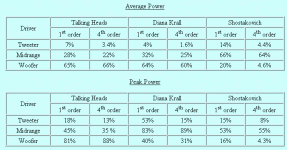It didn't read like that.
"a succession of pulse may result in greater heating" - no John, it WILL result in greater heating - two pulses, twice the heat, three, three times, etc. It doesn't take many pulses until you have a lot of heating. Your own data showed that a tweeter has time constants on the order of ms - thats what "over time" means here. Its not the effect on a single impulse that I am concerned with but the effect on a string of them, ala noise or music. I think you are looking at it the wrong way.
I looked at your results and see support that it is a possibility and you see it otherwise - what can I say.
Earl,
You completely miss what these figures are saying. Remember, cooling has been ignored. Thus looking at this figure which is for 28.3 V and goes out to 1 sec. it tells me the following. If the temperature at the application of the pulse is T*, then I can compute (T*-To)/To and go to the time, t*, location on the red curve where (T-To)/To is equal to that value. That is the t=0 for the pulse. Then if the pulse I am considering has a duration of td, the pulse ends at t= t*+ td on the plot. I can read the value of (T-To)/To at that time call it (T**-To)/To. Then, backing out T**, (T**-T*) is the rise in VC temp dues to the pulse. But the rise will always be greatest between t = 0 and t = td. That is the rise will always be greastest when starting at room temperature.
Now, since cooling is not yet considered, it makes no difference is I have 1 pulse of 100 msec duration or 100 pulses of 1 msec duration. The maximum change in VC temperature due to either (regardless of spacing between pulses) is given for any starting temperature by locating the time where (T-To)/To is equal to the value for the starting temperature and then going out 100 msec. to find the rise. For example, 1 pulse of 1 sec duration starting from T= To, or 1000, 1 msec pulses in succession will yield a rise in (T-To)/To to 2.0, or the VC temp will be 3 To at the end of 1 sec. This is the maximum rise in temperature that could occur. If there were cooling involved, and each of the 1000 pulses were separated by some finite time, then the rise would be less dues to the relaxation between pulses. Like wise, if it was a single 1 sec pulse, the rise would be less because the rate of increase would decrease as time went by because of cooling.
I don't disagree that the multiple pulses results in heating of the VC over time. And while the first pule in the 1000 pulse chain would be reproduced at the 110.5dB level, the 1000th pulse would be at 108.74dB. So, yes, there may be compression due to thermal effects (I say may because with cooling it is possible the temperature relaxes back to the value at the start of the pulse, depending on the interval between pulses). That is not in dispute. But, and I guess there is were Internet terminology gets in the way, I would not refer to that as dynamic compression. To me that is just compression due to longer term operation at high power. When I think "dynamic compression" I am thinking of a case where the temperature rise actually alters the amplitude over the duration of a short term (like 1 msec) pulse. That is a short term, high amplitude dynamic event, like a rim shot, actually suffers "self compression. So, yes, the 1000th pulse is reproduced at a level 1.76dB lower than the 1st, but the difference between the 999th and 1000th is negligible. Self compression is negotiable if the duration of the event is short, short be defined arbitrarily as, for example, not more that 1/2 dB or what ever you like. 1/2dB would translate to no more that a 12% increase in Re over the transient or a 30 degree C temperature rise. If you like 0.1 dB then a 2.3% increase in Re or a 6 degree C rise.
As I said, I performed the analysis w/o bias. How the web page reads reflects my interpretation of the results.
Furthermore, looking at the last plot which probably should be first (but I didn't think about that until I saw the results of the analysis) if the operating temperature of the VC stays below 400 C (which I suspect is extreme considering the comments about ferrofluid from the manufacture), then the entire thermal compressing thing is limited to about 2 dB, significant, but not dramatic.
We can argue about the interpretation but not the results. The analysis is simple and straight forward: Heat in goes to increase in T.
